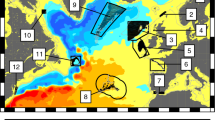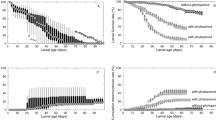Abstract
MARINE species commonly have broadly dispersing juveniles called larvae. Their return to the adult populations is highly variable1–3, often generating large fluctuations in population size4–6, yet the causes of the variation are poorly understood. Historically, attention has been focused on the roles of variable reproductive output by adults and variable mortality during larval development7,8. The limited success of these factors as general explanations prompted a more recent focus on the influence of variable transport of the larvae9–13. Here we show that nearly a decade of settlement variation of the barnacle, Semibalanus balanoides (L), closely matched predictions based solely on a transport hypothesis: differences in transport generate recruitment variation by determining whether larvae complete development near a favourable habitat. The irregular nature of coastlines, particularly the presence of bays and estuaries, generates substantial regional variation in coastal transport that may generate correspondingly large variation in recruitment to marine populations.
This is a preview of subscription content, access via your institution
Access options
Subscribe to this journal
Receive 51 print issues and online access
$199.00 per year
only $3.90 per issue
Buy this article
- Purchase on Springer Link
- Instant access to full article PDF
Prices may be subject to local taxes which are calculated during checkout
Similar content being viewed by others
References
Thorson, G. Biol. Rev. 25, 1–45 (1950).
Caffey, H. M. Ecol. Monogr. 55, 313–332 (1985).
Raimondi, P. T. Ecol. Monogr. 60, 283–309 (1990).
Gaines, S. D. & Roughgarden, J. Proc. natn. Acad. Sci. U.S.A. 82, 3707–3711 (1985).
Hughes, T. P. Ecology 71, 12–20 (1990).
Sutherland, J. P. Ecology 71, 955–972 (1990).
Hjort, J. Rapp. P.-v. Réun. Cons. perm. int. Explor. Mer 20, 1–228 (1914).
Sissenwine, M. P. in Exploitation of Marine Communities (ed. May, R.M.) 59–94 (Springer, Berlin, 1984).
Bailey, K. M. Mar. Ecol. Prog. Ser. 6, 1–9 (1981).
Parrish, R. H., Nelson, C. S. & Bakun, A. Biol. Oceanogr. 1, 175–203 (1981).
Kendall, M. A., Bowman, R. S., Williamson, P. & Lewis, J. R. J. mar. biol. Ass. UK 65, 1009–1030 (1985).
Roughgarden, J., Gaines, S. D. & Possingham, H. Science 241, 1460–1466 (1988).
Bartsch, J. et al. Nature 340, 632–636 (1989).
Hawkins, S. J. & Hartnoll, R. G. J. exp. mar. Biol. Ecol. 62, 271–283 (1982).
Kendall, M. A., Bauman, R. S., Williamson, P. & Lewis, J. R. Neth J. Sea Res. 16, 119–126 (1982).
Zeldis, J. R. & Jillett, J. B. J. Plankton Res. 4, 839–857 (1982).
Shanks, A. L. Biol. Bull. 170, 429–440 (1986).
Geyer, W. R. & Signell, R. P. Estuaries 15, 97–108 (1992).
Ketchum, B. H. Ecology 35, 191–200 (1954).
Sulkin, S. D. & VanHeukelen, W. V. in Estuarine Comparisons (ed. Kennedy, V. S.) 459–475 (Academic, New York, 1982).
Morgan, S. G. Ecology 71, 1639–1652 (1990).
Menge, B. A. Ecol. Monogr. 46, 355–393 (1976).
Southward, A. J. J. mar. biol. Ass. UK 71, 495–513 (1991).
Yund, P. O., Gaines, S. D. & Bertness, M. D. Limnol. Oceanogr. 36, 1167–1177 (1991).
Bertness, M. D., Gaines, S. D., Stephens, E. G. & Yund, P. O. J. exp. mar. Biol. Ecol. 156, 199–215 (1992).
Bolin, B. & Rodhe, H. Tellus 25, 58–62 (1973).
Pilson, M. E. Q. Estuaries 8, 2–14 (1985).
Bertness, M. D. & Gaines, S. D. Evolution (in the press).
Author information
Authors and Affiliations
Rights and permissions
About this article
Cite this article
Gaines, S., Bertness, M. Dispersal of juveniles and variable recruitment in sessile marine species. Nature 360, 579–580 (1992). https://doi.org/10.1038/360579a0
Received:
Accepted:
Issue Date:
DOI: https://doi.org/10.1038/360579a0
This article is cited by
-
Effects of different intertidal hard substrates on the recruitment of Crassostrea gigas
Hydrobiologia (2019)
-
Association between the planktonic larval and benthic stages of Manila clam Ruditapes philippinarum in eastern Hokkaido, Japan
Fisheries Science (2018)
-
Upstream—Downstream Shifts in Peak Recruitment of the Native Olympia Oyster in San Francisco Bay During Wet and Dry Years
Estuaries and Coasts (2018)
-
Contrasting post-settlement selection results in many-to-one mapping of high performance phenotypes in the Hawaiian waterfall-climbing goby Sicyopterus stimpsoni
Evolutionary Ecology (2017)
-
New records of decapod species from Malpelo Island, tropical eastern Pacific
Marine Biodiversity (2016)
Comments
By submitting a comment you agree to abide by our Terms and Community Guidelines. If you find something abusive or that does not comply with our terms or guidelines please flag it as inappropriate.



